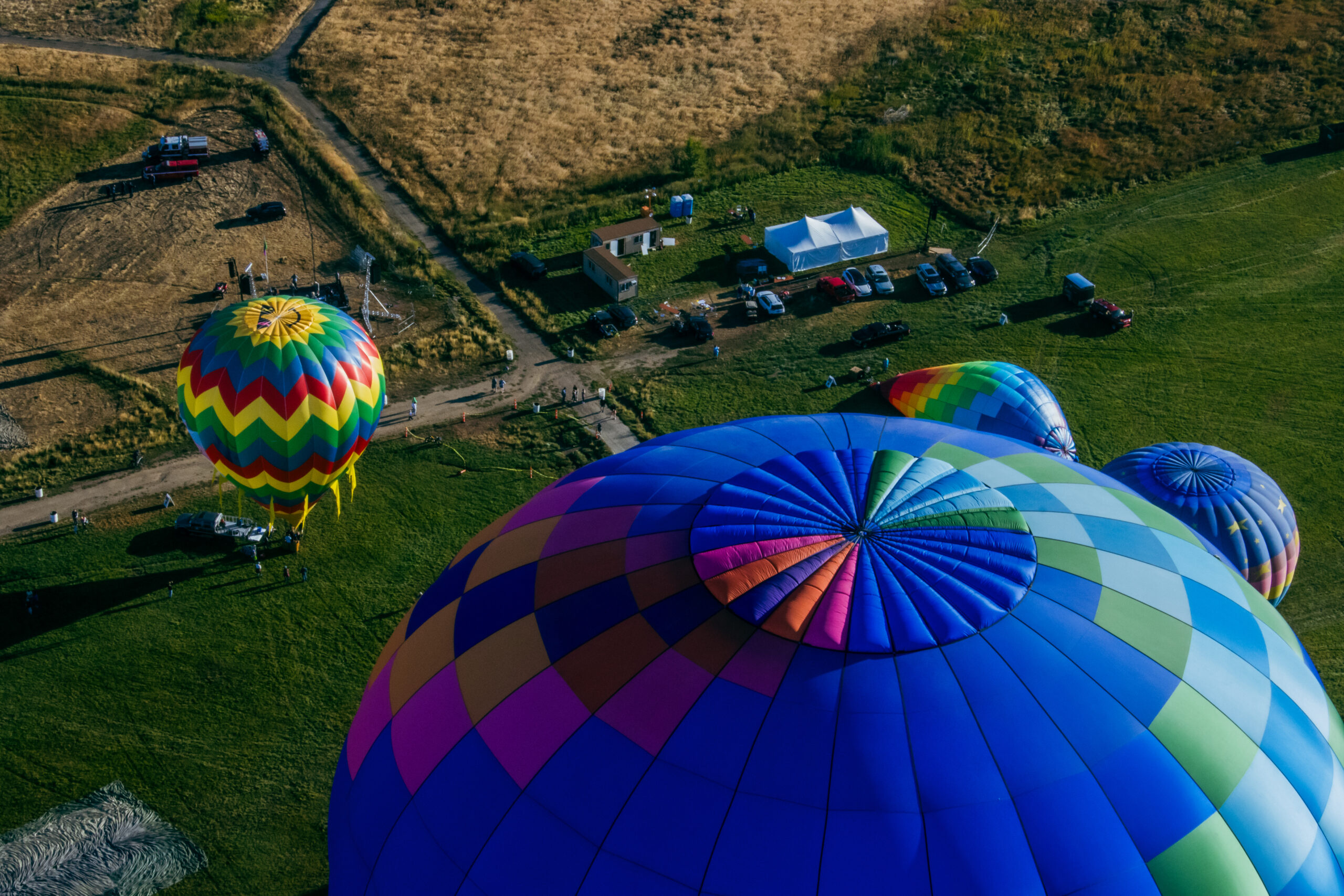If you spotted hot air balloons over campus this past weekend, there’s a perfectly logical explanation. This Sept. 8 to 10 saw the forty-second year of the Great Reno Balloon Race send dozens of hot air balloons into the sky from Rancho San Rafael Regional Park, just northwest of the University of Nevada, Reno. Over these three days, some 150,000 spectators were expected to attend.
The estimate — listed on the event’s official website — is enough to fill the park, and swarm the surrounding hills. Especially on what Brett Oldham, a volunteer on the crew behind one of the balloons, swears is the biggest day of them all.
“Saturday is literally insane,” he said. “I’ve never seen anything like it.”
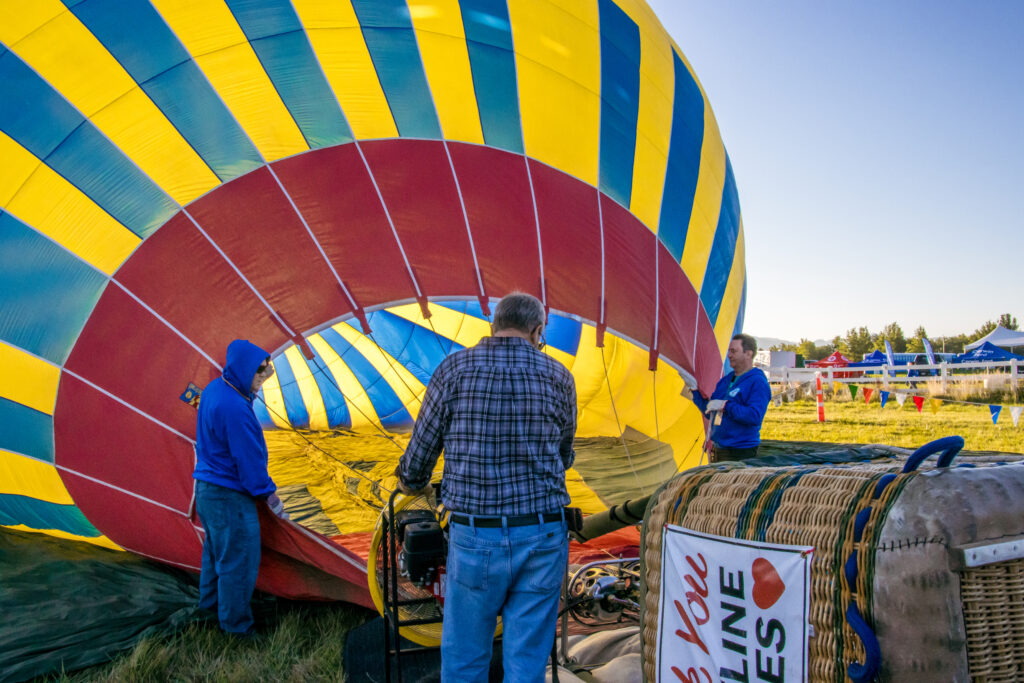
Crew on the Cheers team “coldpack” the resting balloon with cold air. Brett Oldham, holding the scoop at right, is in his second year as a volunteer.
Oldham, who’s in his second year “crew-ing,” bears the official title of “aeronaut” and is part of a small team that makes sure the balloon he’s working on this year, Cheers, can fly. Duties include checking propane tanks, assisting with inflation and acting as a balloon-chaser if the balloon is expected to land out in the city.
“They let us know where they’re going and we try and get there in a truck,” Oldham explained.
It’s crucial they get there in time: when a balloon lands, the same crew that got it in the air has to stop it from taking right back off. In this case, they’re not just fighting the wind: they’re fighting physics itself.
Hot air balloons have only changed slightly since they first flew in France in the 1780s. Heat is added to the balloon from below by burning the propane stored on board in tanks — this was a roaring fire back in the day. The contrast between the less dense, hot air inside and the denser, cooler air outside propels the balloon upwards.
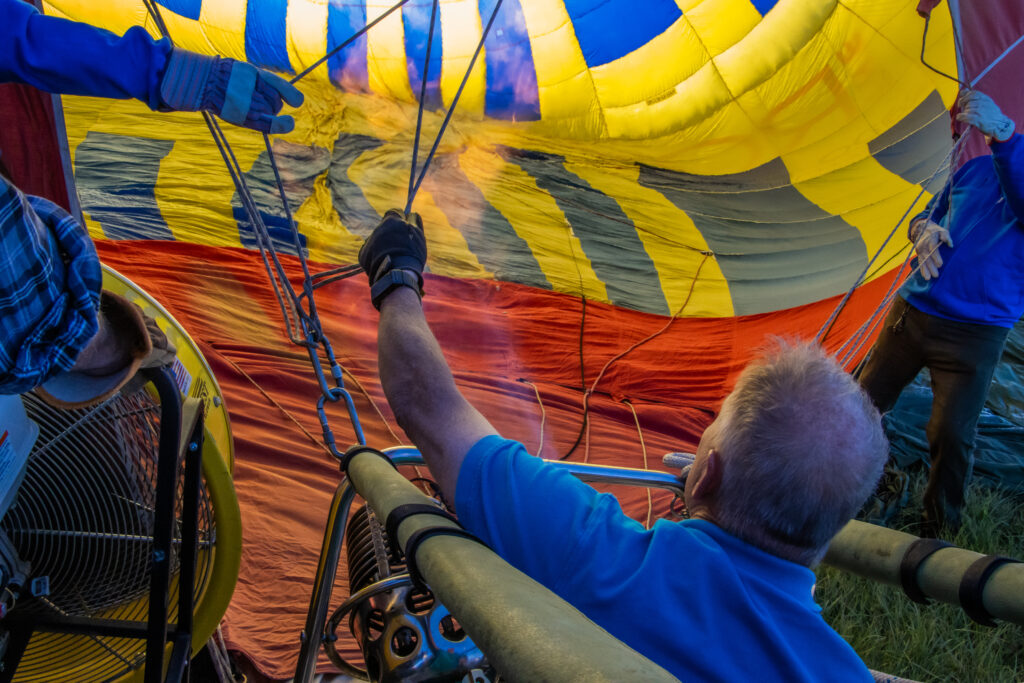
Hot air is pumped into the resting balloon after “coldpacking” is finished. The density gradient between the two air temperatures will eventually allow the balloon to fly.
But here’s the kicker: the pilot can control altitude by adding heat or taking it away. Green and black rope lines dangling from the side allow turning in place with vents in the balloon, and a red and white rope allows deflation. Direction, however, a pilot can only control by proxy. All you can do yourself is go up or down. In order to move, you have to find a current in the air and let the balloon catch it like a sail.
David Wakefield, Cheers’ pilot, has had 24 years of flying to develop a feel for this sort of thing.
“If you see me spitting over the side, that’s not me being crude,” he said. “I’m just trying to figure out which way the wind’s going.”
Wakefield first took to the air in someone else’s balloon in April 1999. He bought his own that August — it was love at first flight. Cheers though, he’s had since 2003, long enough to know its burner and rotation vents like a second skin.
Save a quick glance at an altimeter strapped to one of the poles, Wakefield added, “the rest of it is all seat-of-the-pants. I can feel what we’re doing just by experience.”
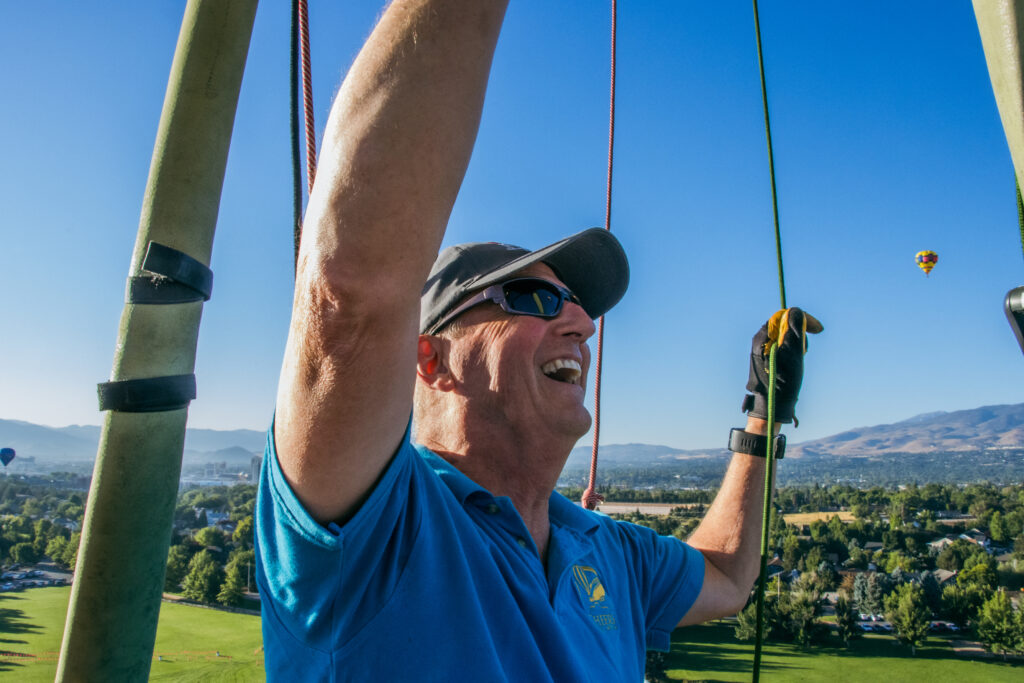
Cheers pilot David Wakefield reaches up for the burner onboard. He grips a rope line to one of the turning vents, in green.
As it turns out, the square wicker basket that holds passengers isn’t just for tradition or show. Even after centuries, it’s still the best material around for the purpose.
“The wicker is very durable, very flexible, very forgiving,” Wakefield said between bursts of propane from the burner. “Other materials can be damaged very easily.”
Even plastic, which has plenty of applications these days, can only make up a portion of the basket. Usually, it’s woven in with the wicker.
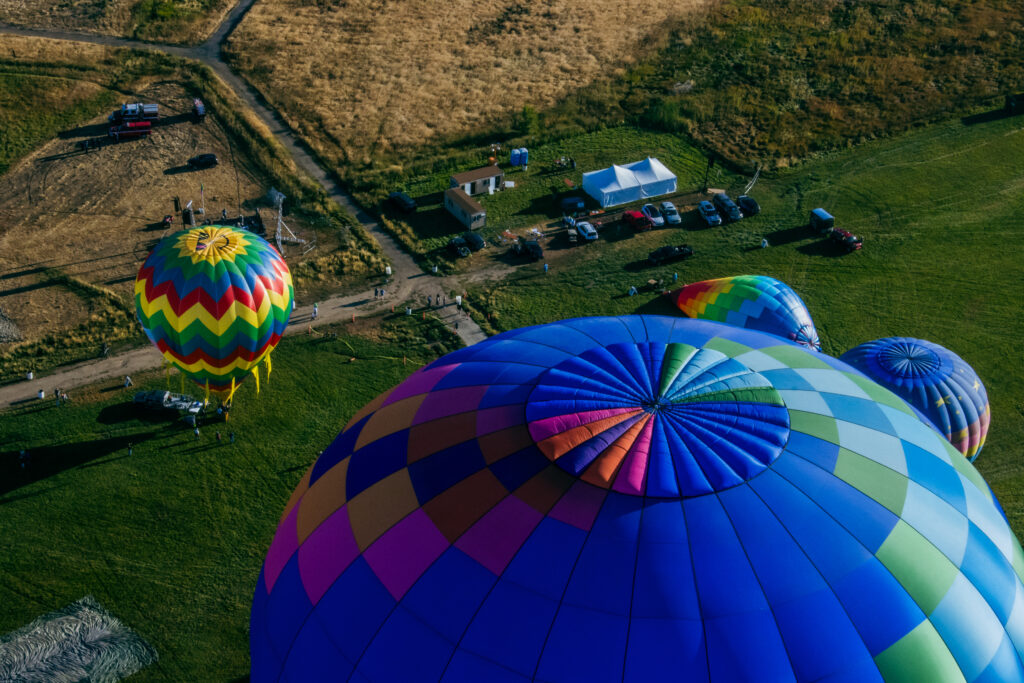
A view of other balloons from overhead. An original Dawn Patrol pilot, Dana Thornton, flies the sun balloon with pennants to the left.
Perhaps because the aircraft itself takes so many cues from the past, ballooning holds a big place for tradition. Nowhere is this more clear than the launch field after the balloon lands.
Shelly Wakefield met David while he was still learning to fly and married him in their balloon. After landing, she offers first-time passengers a hot air balloon notebook, now nearly full, where each can write a message by hand.
Next year, keep an eye out for the unique N-number that identifies Cheers if you see it in the air: it says N804DS. That’s the wedding anniversary of the Wakefields, followed by their initials. When they’re not flying for The Row here in Reno at the race, they run a business together in Sacramento, Calif. called Cheers Aerial Media. They fly banners and advertisements there full-time.
Once the flight is commemorated, Shelly joins the long, laborious process of taking the balloon apart and putting it back. The sturdy, machine-sewn envelope seems deceptively light while in the air, but once it’s deflated via ‘milking,’ it takes a chain of people — passengers included — to get it gathered into a tube and back in its canvas bag.
Once it’s there, everyone who helped has to sit on it.
Suzanne Seiler, longtime crew chief for the retired balloon L’escalier, knows the process well.
When people come out to help for the first time, she said, “They’re like, ‘it’s never going to fit in the envelope!’ Watch. Yes it will.”
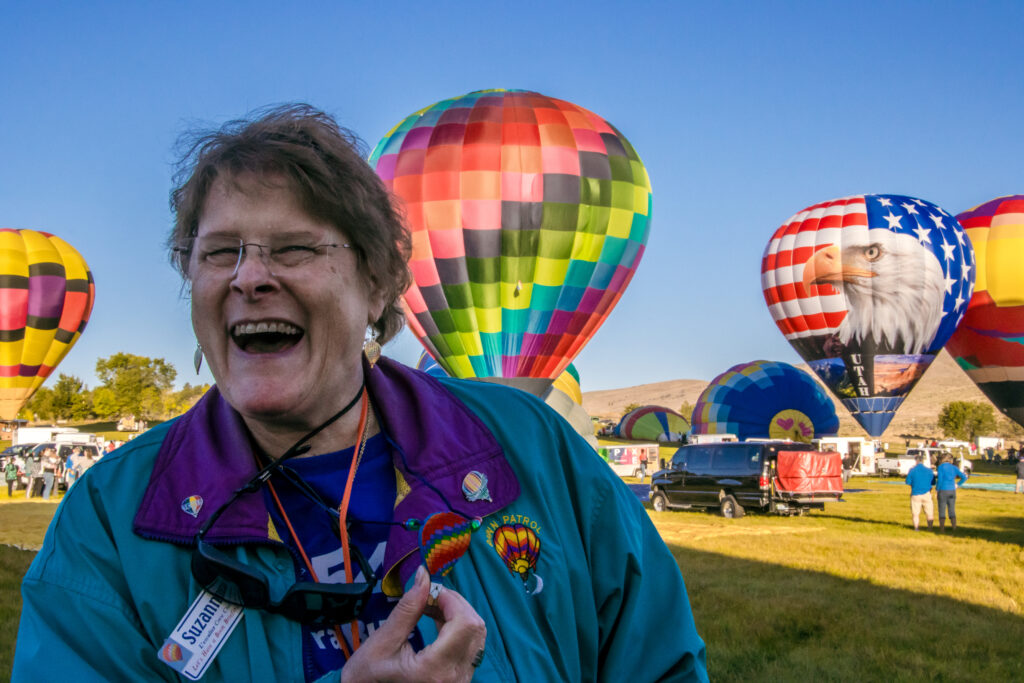
Suzanne Seiler’s balloon L’escalier is now retired, but she still wears the crew chief badge.
Seiler, much like the Wakefields, has been in ballooning for decades and seemed to know everyone on the field. She pointed out the still-aloft balloon of Dana Thornton, the original pilot in the race’s early-morning marquee event, Dawn Patrol.
“His nickname is ‘Boomerang’ because he always — or often — makes his way back to the field,” she said. She then pointed out the Dawn Patrol patch ironed onto the back of her windbreaker, a brightly-colored complement to a pair of hot air balloon earrings.
Though she and her husband Larry no longer fly their own balloon, she’s still deeply involved in the hobby, and believes fervently in giving aeronauts credit where credit is due.
“Don’t let anyone tell you that the Wright brothers were the first ones to fly,” Seiler said with conviction. “It was the balloonists!”
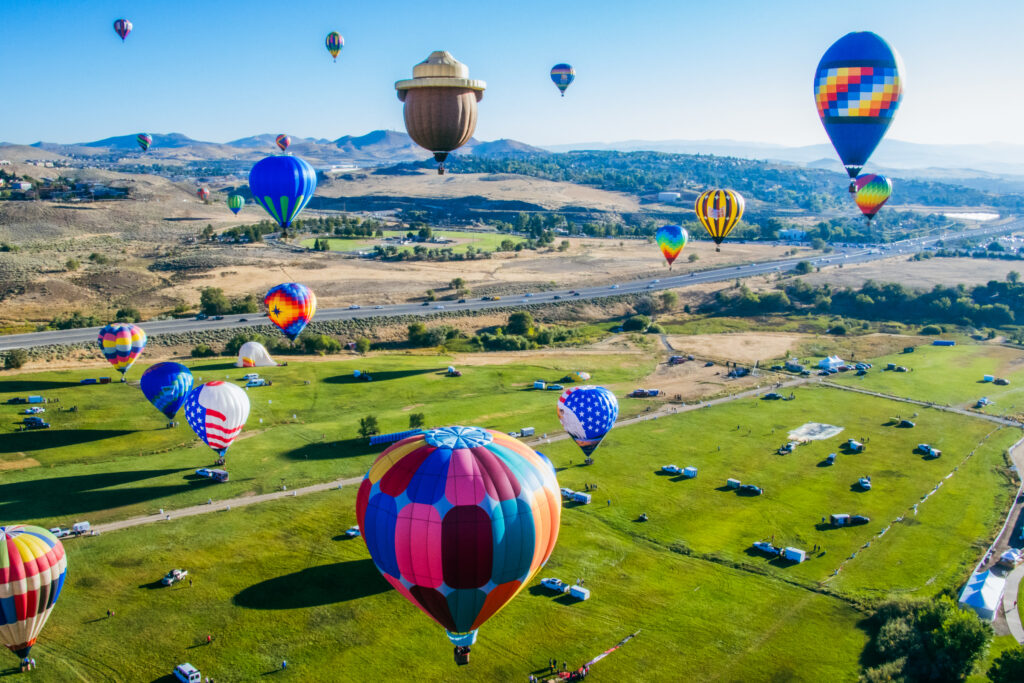
Looking over the basket, dozens of other balloons were visible shortly after takeoff.
Manned, untethered air balloon flight will see its two hundred and fortieth anniversary this November. Like with most things this old or more, there’s a founding legend. After all parts of the balloon had been packed into the truck, Wakefield recounted the one that gives Cheers its name.
As the story goes, pilots would give leery villagers champagne to ease their fears about the mysterious, flaming aircraft descending from the sky. In the present day, this is commemorated with a toast after the Balloonist’s Prayer. It is for this that Wakefield’s balloon is called Cheers.
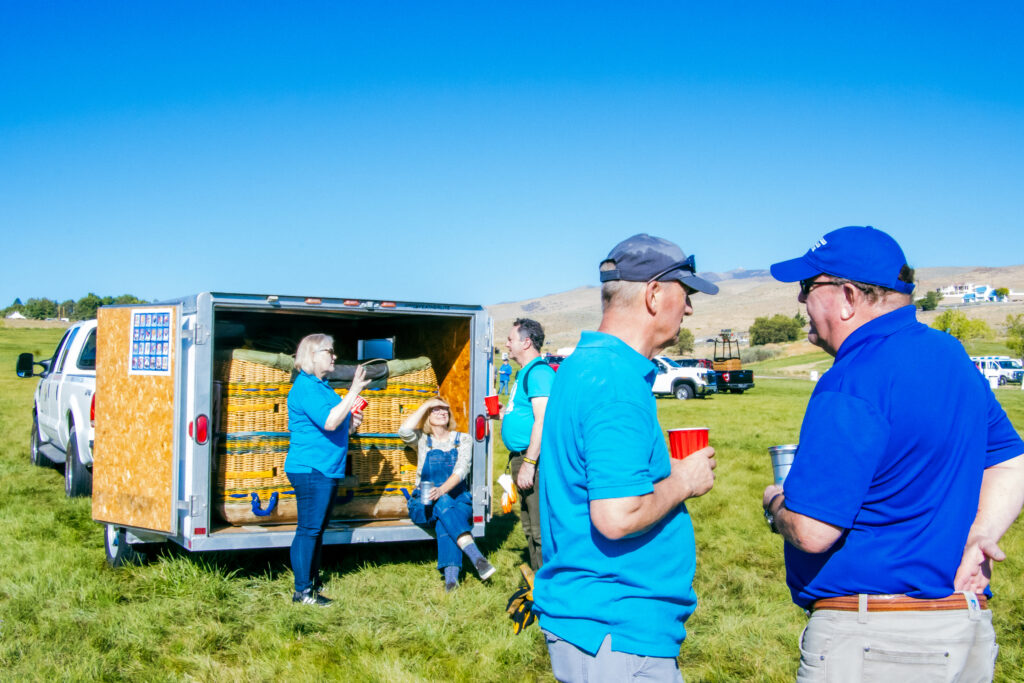
The Cheers team lingers to talk after a celebratory toast. Shelly Wakefield, left, offers passengers a notebook entry to commemorate the ride.
The flight experience itself is certainly one to remember, but it’s the community, the camaraderie and the tradition that makes hot air ballooning truly special.
Besides, Seiler said, “It’s the legal way to get high!”
Peregrine Hart can be reached via email at peregrineh@nevada.unr.edu or on Twitter @pintofperegrine.

